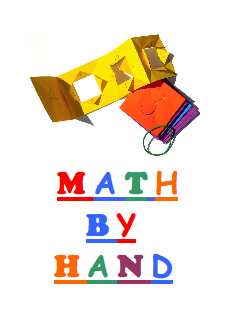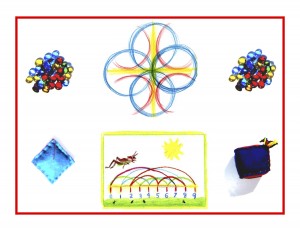
Day 33
For one year, 365 days, this blog will address the Common Core Standards from the perspective of creating an alternate, ambient learning environment for math. Ambient is defined as “existing or present on all sides, an all-encompassing atmosphere.” And ambient music is defined as: “Quiet and relaxing with melodies that repeat many times.”
Why ambient? A math teaching style that’s whole and all encompassing, with themes that repeat many times through the years, is most likely to be effective and successful. Today’s blog will focus on the Snack and Story Time segments of the Kindergarten day, along with suggestions for integrating the Common Core Standards and their ambient math counterparts that appeared in this blog on Days 13, 14, and 15. The approach here will be more general since the posts from Days 13 and 14 echo each other, and the Day 15 post simply suggests combining its math activity with elements from the fairy tales told in the Story segment.
First a word about the nature of the Snack and Story Times and how the two are sometimes combined. Repetition, as the necessary scaffolding for young children, is practiced most of the day in the Waldorf Kindergarten. Many Waldorf Kindergartens have the same foods (often different grains) on the same days of the week. So Monday might be oats, Tuesday, millet, and so on. This anchoring in a familiar, comforting routine is essential to the littlest ones as they bravely navigate through a wonderful, strange, and sometimes frightening world.
Ancient fairy tales, like the Grimm brothers collection, provide an essential mooring for the uncharted and uncertain seas of early childhood. The story is told (ideally told rather than read) by the teacher/parent, and is repeated every day for one to two weeks. The stories go so deep that they are very often acted out in the child(ren)’s play. You might say that they are “trying on” ways to be in the world. This is learning at its most essential, and should definitely not be interrupted by abstract teaching, drills, and tests.
Here is an excerpt from the introduction to the Math By Hand first grade fairy tale book (each number from 1-12 is introduced through its own fairy tale). “In the story ‘The Queen Bee,’ when it was the youngest prince’s turn to seek in the moss for the princesses’ 1,000 pearls, ‘It was so very difficult for him to find the pearls, and he got on so slowly, that he seated himself on a stone, and wept.’ Finding the 1,000 pearls in the moss is parallel to finding the 1,000+ pearls of wisdom embedded in these ancient tales. The 5,000 ants who come to the prince’s aid were sent by the King of Ants whose life he had saved, who had promised to help the young prince if he should ever need it. ‘ . . . and before long, the little creatures had got all the pearls together and laid them in a heap.’
At this particular time in history, as we become increasingly caught up in technology and focused on all things scientific, sacrificing fantasy and the imagination in favor of the rational, there’s an urgent need for the modern mindset to make room for childhood, now at risk, since its very essence is imaginative fantasy. The child’s nature is such that connections to the unconscious are more tangibly apparent than in the adult. It is these closer connections that, combined with childish innocence and vulnerability, create a need for reassurance that all will be well, in the end. Fairy tales fit all of these needs, beautifully and effectively.”
Story and snack can be successfully combined, using stories that fit the particular cooking, baking or other food preparation activity taking place on any particular day. The blog posts for Day 13 suggests using the stone used to cook the stone soup as a likely candidate for this part of the standard: Describe several measurable attributes of a single object. (Find a version of the story in the Day 21 post.) And cooking the stone soup itself nicely fills this part of Day 14’s standard: Compare two objects with a measurable attribute in common, to see which object has more or less of the attribute, describing the difference. Many such opportunities abound while preparing and cooking food!
The Day 15 post’s standard: Classify objects into given categories, and sort the categories by count. fits the fairy tale mentioned above, “The Queen Bee.” It has the elements mentioned at the end of Day 15’s post, and may be an excellent one to adapt to classifying and sorting. Many fairy tales do have this feature in common. Stories, with their vibrant, memorable images, can be the beating, lively heart of all your teaching, from Kindergarten through the upper grades. The Waldorf story curriculum is a study in bringing the child gently into the world, as it morphs from fairy tales, to fables, to myths, to modern history (the latter enlivened with the anecdotal and biographical).
So we come to the end of Kindergarten! At the end of every grade I will attempt an ambient math interpretation of the Standards for Mathematical Practice. There are eight of them and they are quite complex and dense. So, we will see how many days will be needed for this. Please remember that knowledge ensues in an environment dedicated to imaginative, creative knowing, where student and teacher alike surrender to the ensuing of that knowledge as a worthy goal.
Tags:

Day 32
For one year, 365 days, this blog will address the Common Core Standards from the perspective of creating an alternate, ambient learning environment for math. Ambient is defined as “existing or present on all sides, an all-encompassing atmosphere.” And ambient music is defined as: “Quiet and relaxing with melodies that repeat many times.”
Why ambient? A math teaching style that’s whole and all encompassing, with themes that repeat many times through the years, is most likely to be effective and successful. Today’s blog will focus on the Outside Time segment of the Kindergarten day, with suggestions for integrating the Common Core Standards and their ambient math counterparts that appeared in this blog on Days 8, 9, and 18. The standards may be paraphrased and will appear in blue.
First a note on the Outside Time and its function, both in the Waldorf Classroom and in the homeschool setting. Outdoor play is essential to us all, but especially young children! If you think about your typical day, you will be shocked at how little of it is spent outdoors. I know I don’t get out there nearly as much as I’d like or need to. The walk from the house to the car, and then from the car to the store, dance studio, library, etc. We’ve lost our heritage: that of our connection to everything found outside.
As a child of the 50’s I was out of the house every day without exception, from 3 pm till dinnertime, and after dinner till bedtime when daylight permitted. Summers and vacations, I was outside all day. I lived on a dead-end street, no cars to speak of, so it was a huge asphalt playground for the whole neighborhood. Let’s see, roller skating (with a skate key on a cord around my neck), stoop ball (with those amazing pink rubber balls), sledding in the winter, every street game you can think of (hopscotch, red light-green light, hide and seek . . . ), and more!
Outside should be an integral part of every school day, especially the Kindergarten day. “Forest Kindergartens” are cropping up everywhere around the world. They’re held outside, literally in the forest, every day, rain or shine. Parents dress their child(ren) appropriately, knowing that the children are only brought in when the weather is extremely hot, cold, or stormy. Mother Nature teaches most lessons. “Nature Deficit Disorder” is real. It was coined by Richard Louv who wrote a book called “Last Child in the Woods,” which has sparked many organizations devoted to spreading the word. “No Child Left Inside” is a movement and an awareness that’s gaining momentum.
Time outside should be devoted to pure play and exploration. That said, there are many academic lessons that would do well in an outdoor setting. Although only three of the blog Days are featured here, please do not hesitate to adapt any of the activities and lessons to the great outdoors. Read the suggestions below in that light.
Day 8
Operations and Algebraic Thinking K.OA
Understand addition as putting together and adding to, and understand subtraction as taking apart and taking from. 2. Solve addition and subtraction word problems, add and subtract within 10 by using objects to represent the problem.
Using content from a familiar rhyme, song, or story helps to provide a familiar, lively context for word problems, keeping them from being overly abstract. Play acting and movement are wonderful here as well, as the child(ren) bring the song, rhyme, or story to life. Use natural objects like sticks and stones as counters.
Day 9
Operations and Algebraic Thinking K.OA
3. Use objects to decompose numbers less than or equal to 10 into pairs in more than one way.
All of the activities in this post can be taken outdoors, including the drawing part. Use sidewalk chalk to make the circles on pavement, or a simple stick to draw them on the ground. The constructed circles and their activities outlined in this post work really well outdoors, especially the flags. That one’s my favorite. Do have the child(ren) help make them, since there’s no investment in learning like making their own learning materials. The main reason I like this one so much is because it’s large and colorful, which seems to be the winning recipe for engagement and success. And do liberally mix in fun and games, remembering that play is always, always paramount.
Day 18
Geometry K.G
Analyze, compare, create, and compose shapes.
4. Analyze and compare two-dimensional shapes, using informal language to describe their similarities and differences.
Informal language can also be non-verbal. Experience is the best teacher. A concept brought in a concrete rather than abstract way is most successful. Using the pegs and colorful yarn to create the outlines of shapes on the grass can be a truly dynamic lesson because the sharp corners of the square and triangle vs. the flowing round shape of the circle will be qualities that are experienced and remembered far more than if the shapes are circled or chosen on a worksheet.
Knowledge ensues in an environment dedicated to imaginative, creative knowing, where student and teacher alike surrender to the ensuing of that knowledge as a worthy goal. More Kindergarten tomorrow!
Tags:
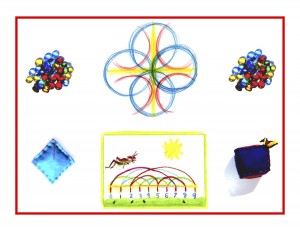
Day 30
For one year, 365 days, this blog will address the Common Core Standards from the perspective of creating an alternate, ambient learning environment for math. Ambient is defined as “existing or present on all sides, an all-encompassing atmosphere.” And ambient music is defined as: “Quiet and relaxing with melodies that repeat many times.”
Why ambient? A math teaching style that’s whole and all encompassing, with themes that repeat many times through the years, is most likely to be effective and successful. Today’s blog will focus on the Circle Time segment of the Kindergarten day, with suggestions for integrating the Common Core Standards and the ambient math counterparts that appeared in this blog on Days 3, 5, 7, and 13. The standards may be paraphrased and will appear in blue.
A bit off-topic, but as I sit here about to write Day 30’s post my husband is watching Shark Tank, the high-stakes TV show that pairs entrepreneurs with potential investors. The current hopeful has invented yet another app for the mobile phone, and the sharks are crazily bidding up against each other. So here I sit with a patently low-tech math product that’s low-tech for very good reasons. One of which is that the nature of teaching and learning must be personal: a human, student-mentor connection is an essential element. We seem to be so sold on the new that the tried and true basics are falling by the wayside. Many computer math apps promise fun and instant success, however do note that a trend toward “slow” is gaining in popularity. Slow food, slow parenting, and slow math, because anything worthwhile is worth waiting for. Do wait with/for your child(ren) through a healthily slow learning pace. And I need to wait for Math By Hand to win the slow race to the top amongst all those colorful, fun apps!
Day 3
Counting and Cardinality K.CC
Know number names and the count sequence.
1. Count to 100 by ones and tens. 2. Count forward from any number, rather than having to begin at one.
Math is integrated into the Morning Circle from Grade 1 on, but typically not included in the Kindergarten Circle. There are so many fun number songs though, including “Over In the Meadow” and “Bottles On the Wall” as suggested here. The Circle is a lively mix of recitation, singing, play-acting, and movement, and teaching songs or verses with movement provides all of the above. Number names and the count sequence are learned with both songs. Counting to 100 forward, backwards, by 10’s and 20’s, and random sequence are all covered with the “Bottles On the Wall” song.
Day 5
Counting and Cardinality K.CC
5. Arrange as many as 20 objects in a line, rectangular array, or circle, or as many as 10 in a scattered configuration. Give a number from 1-20 and count out that many objects.
Jumping the circles on the floor from 1-10 or 1-20 brings the counting together with large movement, thus enhancing retention and promoting a lively eagerness to participate. Singing or reciting “One, Two, Buckle My Shoe” is a big help because the numbers are in context, and the rhyming and singing are excellent memorization tools. The construction paper circles could be no bigger than a foot in diameter. You may want to have dots (like the counting stones) on one side for number recognition, and the other side blank for use with the arrays. Say, “five” while pointing to the 5 counting stone, have the child(ren) place that many circles on the floor, then jump and count them.
Day 7
Operations and Algebraic Thinking K.OA
Understand additions as putting together and adding to, and understand subtraction as taking apart and taking from.
1. Represent addition and subtraction with sounds, acting out, verbal expressions.
Say the words add! or more! then: 3 claps – space – 2 claps, as a call and response to which the child(ren) respond with 5 claps. Say the words take away! or less! then: 3 claps – space – 1 clap, as a call and response to which the child(ren) respond with 2 claps. Do make it more fun with jumping, marching, or playing something (drum or tambourine) as an accompaniment instead of clapping!
Day 13
Measurement and Data K.MD
Describe and compare measurable attributes.
1. Describe several measurable attributes of a single object.
Take the variety of small objects gathered from around the house into the circle. Pass them around one at a time, pairing one descriptive word with each object and having each child repeat the word as s/he receives the object. After the passing game has been played for a while, each child could come up with a different descriptive word as s/he receives the object.
Knowledge ensues in an environment dedicated to imaginative, creative knowing, where student and teacher alike surrender to the ensuing of that knowledge as a worthy goal. So, on to Kindergarten tomorrow!
Tags:
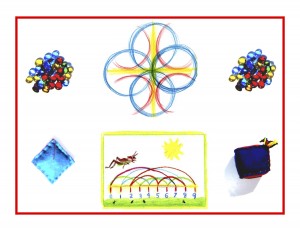
Day 28
For one year, 365 days, this blog will address the Common Core Standards from the perspective of creating an alternate, ambient learning environment for math. Ambient is defined as “existing or present on all sides, an all-encompassing atmosphere.” And ambient music is defined as: “Quiet and relaxing with melodies that repeat many times.”
Why ambient? A math teaching style that’s whole and all encompassing, with themes that repeat many times through the years, is most likely to be effective and successful. Today’s blog will focus on the Kindergarten Common Core Math Standards and ambient counterparts that appeared in this blog on Days 17, 18 and 19. Note: standards may be paraphrased and will appear in blue.
Self-generated interest, especially at this age, is the most effective. There’s a wonderful willfulness that predominates in the child’s personality before the age of reason, that can be worked with to the advantage of everyone concerned! I always believed that a strong will in a child should be respected as a boon and a gift. Boundaries must be set and faithfully kept of course, but attempting to bend a child’s will to that of an adult can be frustratingly fruitless, so in that light, rely on the sweetness and allure of what you are doing to draw the child into any sphere of interest.
Day 17
Geometry K.G
Identify and describe shapes (squares, circles, triangles, rectangles, hexagons, cubes, cones, cylinders, and spheres).
2. Correctly name shapes regardless of their orientations or overall size. 3. Identify shapes as two-dimensional (lying in a plane, flat) or three-dimensional (solid).
Make the felt and paper hexagrams using the directions at the bottom of this post. No need for fanfare or announcements, just begin working at a table while the child(ren) play around you. Sing and finger-play the bee song while putting the gold felt hexagons together, then store them in a basket or bin in the Math Corner for free play. You may want to mix in some beeswax hexagons, and why not sculpt some beeswax bees? (Beeswax is the best modeling medium for young children.) Cutting the paper snowflakes should always be a guided activity. Introduce the varying sizes of the shapes and the comparison with the sandpaper shapes, then make these available in the Math Corner for free play as well. Start out one on one with the flat and solid shapes, but this activity could later be expanded to Circle Time.
Day 18
Geometry K.G
4. Analyze and compare two- and three-dimensional shapes, developing a familiarity with their differences and similarities, while using informal language to describe them.
Informal language can include the non-verbal, as shapes are experienced in a pure play mode: how different the bouncy sphere (exercise ball) feels from the sharp-cornered cardboard box, or the pointy cone! Guide little fingers and hands to feel the differences between the wooden and sandpaper shapes, then see this repeated often in the Math Corner. The large shapes activities are best set in Circle Time or Outside, look for them there. The cardboard tube cookie cutters however, are a perfect fit for the Free Play segment. This needs to be a more formal, guided activity rather than left for independent play. Do have fun with the large shapes during free play, both cardboard and fabric. I do encourage you to make the very large fabric shapes for boundless fun!
Day 19
Geometry K.G
5. Model and draw shapes, building them from components. 6. Compose simple shapes to form larger shapes.
Making the shapes with sticks for mobiles and constructing the god’s eyes are a good fit for free play time, but with guidance. The clay shapes and potato prints are a good fit for free play, again with guidance. See the play clay recipe at the bottom of the post. I just looked online and found real cookie cutter sets in shapes: circles, squares, and triangles!
Knowledge ensues in an environment dedicated to imaginative, creative knowing, where student and teacher alike surrender to the ensuing of that knowledge as a worthy goal. More Kindergarten tomorrow!
Tags:
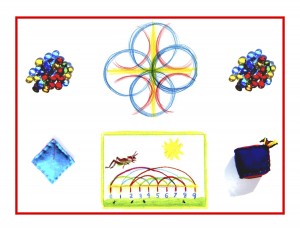
Day 27
For one year, 365 days, this blog will address the Common Core Standards from the perspective of creating an alternate, ambient learning environment for math. Ambient is defined as “existing or present on all sides, an all-encompassing atmosphere.” And ambient music is defined as: “Quiet and relaxing with melodies that repeat many times.”
Why ambient? A math teaching style that’s whole and all encompassing, with themes that repeat many times through the years, is most likely to be effective and successful. Today’s blog will focus on the Kindergarten Common Core Math Standards and ambient counterparts that appeared in this blog on Days 13, 15, and 16. Note: standards may be paraphrased and will appear in blue.
In the Waldorf School, learning about time and measurement does not happen until third grade. As with many other elements, exposure to time and measurement will most likely happen way before third grade, but its formal introduction doesn’t happen till then. The reasoning is that the child crosses a significant boundary at age 9. Just as a readiness for learning becomes optimal at age 7, the first real steps out of the garden of childhood are taken two years later, at 9.
Creation stories are told at this age, as the child’s powers of reasoning develop alongside a beginning recognition of the realities of growing up. The expulsion from the garden is a thread that runs through most cultures’ creation stories, and is a theme that fits this stage of development well. This age then also becomes a perfect window to teach practical things like housebuilding and farming / gardening, because that’s how we collectively learned to live on the earth, on our own, after leaving our respective gardens. Time and measurement fit this context nicely. That said, aspects of it can be taught and absorbed (rather than learned) in a purely experiential and playful way.
Day 13
Measurement and Data K.MD
Describe and compare measurable attributes.
1. Explore measurable attributes of objects like length or weight, experience and describe several measurable attributes of a single object.
Gathering small objects for a simple, close game of catch should happen one-on-one, adult to child at first. This could fit into the free play time in a subtle way, with the objects in a basket by your side, casually initiating the game. Because imitation is so strong now, showing the unique qualities of each object as you select, handle, and exchange each one would be optimal. Choose objects that would be suitable to eventually be made available for play in the Math Corner. Tell the Stone Soup story from the Day 21 post (or another version) before exploring the properties of the stone you will use to make stone soup. (Day 14 is devoted to cooking in general, and making the stone soup, so it will appear in the Snack/Story segment.)
Day 15
Measurement and Data K.MD
3. Sort different objects into categories, and determine the relative numbers of each.
Today’s activity is simple and straightforward. Mixing three different collections of natural objects together in varying amounts and providing three empty baskets to sort them into fulfills this standard, short of counting the objects in each basket. A feel for the volume of each is how their relative amounts will be experienced. Your Kindergartner loves to sort, and s/he will be happily engaged with this, with or without your guidance. Do connect it to one of the classic fairy tales after telling the story, for added fun and relevance.
Geometry is touched on informally from the Waldorf first to fifth grades, through form drawing. It is taught formally with precision and instruments in the sixth grade. The Platonic Solids are examples of forms that are deeply archetypal. Form drawing is approached and taught with an awareness of this, and it does resonate very deeply for the children. As a Waldorf class teacher, I began each school year with a week of form drawing main lessons every day, and brought it back every Monday for the whole year. A playful approach is best for accessing the necessary archetypal mood now.
Day 16
Geometry K.G
Identify and describe shapes (squares, circles, triangles, rectangles, hexagons, cubes, cones, cylinders, and spheres).
1. Describe objects in the environment using names of shapes, and describe the relative positions of these objects using terms such as above, below, beside, in front of, behind, and next to.
As mentioned in this post, my internet search for hands-on activities resulted in a lot of worksheets and plastic shape sorting sets. Much more subtlety is needed here. Montessori uses sandpaper letters and numbers, but this will also do for experiencing the shapes and their differences. Please do have the child(ren) participate in making anything like this, it means so much to them to be doing useful work! After you’ve guided the child(ren) a bit with these they can be stored in the Math Corner for free play. Same for the “Guess the Shape” pouch. The large outlined shapes and the positioning activities will be covered in the Circle Time segment.
Knowledge ensues in an environment dedicated to imaginative, creative knowing, where student and teacher alike surrender to the ensuing of that knowledge as a worthy goal. More Kindergarten tomorrow!
Tags:
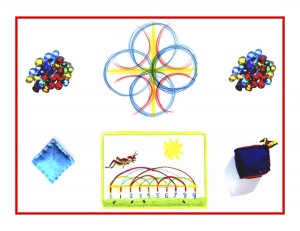
Day 26
For one year, 365 days, this blog will address the Common Core Standards from the perspective of creating an alternate, ambient learning environment for math. Ambient is defined as “existing or present on all sides, an all-encompassing atmosphere.” And ambient music is defined as: “Quiet and relaxing with melodies that repeat many times.”
Why ambient? A math teaching style that’s whole and all encompassing, with themes that repeat many times through the years, is most likely to be effective and successful. Today’s blog will focus on the Kindergarten Common Core Math Standards and ambient counterparts that appeared in this blog on Days 10, 11, and 12. Note that the standards will be paraphrased and will appear in blue.
Day 26, 339 days to go. For the most part, this has been joyful work. I love the challenge of fitting creative activities into the most unlikely places, a self-styled “mother of invention” of sorts. I have worked with the Math By Hand project for some eight years now, and its growth has been phenomenal. For a small business, it’s been very successful. Typical of most small businesses though, the hours are many and long. Adding this daily blog posting to an already long day was/is a daunting prospect. And it’s been good, but I guess I’m in a bit of a cyber bubble, wondering if anyone’s out there. Faith does win the day however, and I do have that. So! On to Day 10.
Day 10
Operations and Algebraic Thinking K.OA
Understand addition as putting together and adding to, and subtraction as taking apart and taking from.
4. Use objects or drawings to find the number that makes 10 when added to any given number and record the answer with a drawing or equation.
Peter Rabbit and a rope can help with this understanding! The Beatrix Potter story could be told the day (or again and again for several days) before doing this with the child(ren). The rope and/or cloth as described in the post help to make the numbers and their relationship to the number 10 tangible. The story provides a lively background and a picture image for both learning how to tie the knots and showing what the number 10 and parts of it look like. The little drawing at the bottom of the post fills the standard’s requirement for recording the answer with a drawing. Several drawings could be made, with the number of holes varying between 1 and 10. After this activity has been introduced, it can be repeated with guidance. No formal teaching is necessary or desirable here, rather a spontaneous, joyful imitation should predominate within the free play segment.
Day 11
Operations and Algebraic Thinking K.OA
5. Fluently add and subtract within 5.
This post emphasizes the fact that testing and abstract learning have no place in the Kindergarten if the true beauty of math is to shine through, as a preventive of fears and phobias, engendering a life-long love of the subject. Objects are used to achieve fluency, and aspects of the 4 processes are introduced in a very rudimentary and concrete way. For the written portion, counting lines are again used instead of numbers, but the plus, minus, and equals signs are added to the mix. Using the picture stories suggested will insure that the first exposure to these abstract signs is manageable and age-appropriate.
Day 12
Number and Operations in Base Ten K.NBT
Work with numbers 11-19 to gain foundations for place value.
1. Compose and decompose (put together and take apart) numbers from 11-19 to show that the numbers 1-9 are added to 10 to make up the numbers 11-19.
Place value in the Math By Hand, Waldorf, and until recently, most educational theory and systems, has been reserved for a much later time. Mid to late second grade is an optimal time to teach this concept. Having Kindergartners do worksheets to learn place value is mistaken and even punishing. Forcing a child to go beyond his or her natural capacity is fruitless, frustrating, and can even be destructive of positive attitudes toward learning in future. So if place value comes in the Kindergarten at all, it must be in a very unconscious, playful mode. The jars and beans from the Day 4 post could be brought back as a refresher (or better, if they’re in the Math Corner, they’ve been played with since). As with the Peter Rabbit story, the Squirrel Nutkin one could be told the day (or several days) before, so the activity has a friendly, pictorial basis. Note that two kinds of counting happen here: 1-9 (each number in its own circled grouping) is said while drawing the acorns, then as the stems are added, 11-19 is said. One becomes eleven, two – twelve, three – thirteen, and so on. But do remember that all of it must be very casual and experiential, and directly referenced to real objects. Most importantly, at any sign of stress or difficulty, always revert to pure play.
Knowledge ensues in an environment dedicated to imaginative, creative knowing, where student and teacher alike surrender to the ensuing of that knowledge as a worthy goal. More Kindergarten tomorrow!
Tags:
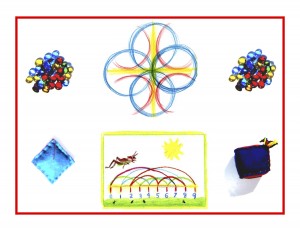
Day 25
For one year, 365 days, this blog will address the Common Core Standards from the perspective of creating an alternate, ambient learning environment for math. Ambient is defined as “existing or present on all sides, an all-encompassing atmosphere.” And ambient music is defined as: “Quiet and relaxing with melodies that repeat many times.”
Why ambient? A math teaching style that’s whole and all encompassing, with themes that repeat many times through the years, is most likely to be effective and successful. Today’s blog will focus on the Kindergarten Common Core Math Standards and ambient counterparts that appeared in this blog on Days 7, 8, and 9. Note that the standards will be paraphrased and will appear in blue.
Day 7
Operations and Algebraic Thinking K.OA
Understand addition as putting together and adding to and subtraction as taking apart and taking from.
1. Represent addition and subtraction with objects, finger counting, mental images, drawings, sounds (i.e. clapping), acting out, explaining in words, expressions, or equations.
Addition is practiced by combining counting stones and natural objects, counting both out loud then using a counting stone to represent the total. Subtraction is practiced by using counting stones only, covering some of the dots while saying the equation out loud then using a counting stone to represent the total. Store these materials in the Math Corner for free or gently guided play after they’ve been introduced. As stated in the post, these activities should always be experiential and child-motivated, similar to a Montessori approach. Remember that the optimal mood at this age is playful and joyful! (Look for the other activity in this post in the Circle Time and Outside segments.)
Day 8
Operations and Algebraic Thinking K.OA
2. Solve addition and subtraction word problems. Add and subtract up to 10, using objects or drawings.
The word problems are based on known rhymes and songs from the Circle Time, so there’s a familiar reference. Preferably this activity would be taken outside, using straight sticks as counters, for both addition and subtraction. The sticks can be brought inside if weather doesn’t permit being outside. For the writing portion, the numbers can again be represented by counting lines (see Day 6), either using a stick in the sand or dirt, or crayons on paper. For use after this has been introduced, substitute baskets of craft or popsicle sticks, stored in the Math Corner for free or gently guided play. (For more information on doing this outdoors, see the Outside segment.)
Day 9
Operations and Algebraic Thinking K.OA
3. Decompose (take apart) numbers from 1-10 or lower using objects, and record them as drawings or equations.
Large, colorful circles in sets of three are made with various materials and used to represent the whole number and the two other numbers that make up its parts. (Look for the activities in the Circle Time or Outside segments.) After these activities become familiar, the concept can be practiced on paper during Free Play time. Using small, flat objects placed inside the circles on poster board, do the same activity to decompose or take apart the numbers then record these equations with rubbings (this must be a guided activity). Store the hula hoops in the Math Corner for either math or joyful play!
Knowledge ensues in an environment dedicated to imaginative, creative knowing, where student and teacher alike surrender to the ensuing of that knowledge as a worthy goal. More Kindergarten tomorrow!
Tags:
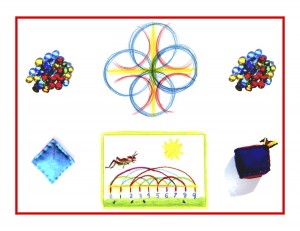
Day 24
For one year, 365 days, this blog will address the Common Core Standards from the perspective of creating an alternate, ambient learning environment for math. Ambient is defined as “existing or present on all sides, an all-encompassing atmosphere.” And ambient music is defined as: “Quiet and relaxing with melodies that repeat many times.”
Why ambient? A math teaching style that’s whole and all encompassing, with themes that repeat many times through the years, is most likely to be effective and successful. Today’s blog will focus on the Kindergarten Common Core Math Standards and ambient counterparts that appeared in this blog on Days 4, 5, and 6. (Looks like I will be doing five groups of three posts, rather than three groups of five (too much good content to share). Note that the standards will be paraphrased and will appear in blue.
Day 4
Counting and Cardinality K.CC
Count to tell the number of objects.
4. Relationship of number to quantity: counting and cardinality.
a) Recognize the counting order of numbers, and that each named number is unique to its quantity.
b) The number of objects is the same regardless of their arrangement or order.
c) Each successive number name represents a quantity that’s one larger.
This activity uses jars and beans to show the uniqueness of each number up to 20 through the number of beans inside the jars, while demonstrating that the jars themselves can also be counted as objects, regardless of their bean/number contents. It would be a good idea to seal these jars so the contents can’t be changed. At the same time, a nice variation would be to have two small bins of the black and kidney beans along with empty jars available so the child(ren) can experiment with counting and filling the jars themselves. As with other activities brought to the Free Play time, this activity could be introduced and then made available in the Math Corner for free or gently guided play.
Day 5
Counting and Cardinality K.CC
Count to tell the number of objects.
5. Arranging up to 20 objects in a line, a rectangular array, or a circle, count how many. Do the same with up to 10 scattered objects.
The essence of each number is conveyed visually without getting too abstract by using stone counters. Each one can represent a number up to 10, and then used together with blank stones to determine the number of objects. Here’s how: take 5 blank stones and line them up next to the group of counting stones to 10. Ask which counting stone matches each blank stones’ configuration. (Yesterday’s number jars can be used for counting up to 20.) Have the children help gather the stones (flat ovals are best) and also be very present when you apply the dots, counting as you go. These materials can be stored in the Math Corner for free or gently guided play after they’re introduced. (Look for the other activities in this post in the Circle Time and Outside segments.)
Day 6
Counting and Cardinality K.CC
Compare numbers.
6. Know whether numbers in two groups are greater than, less than, or equal to one another.
7. Compare two numbers between 1 and 10 as written numbers.
Yesterday’s counting stones could be paired with natural counting objects like acorns, shells, glass beads, or small stones for the purpose of comparing and matching. The symbols for “greater and less than” could be introduced very pictorially as described in the Day 6 post. Go to the bottom of the Day 11 post to see how to introduce the equals or “is” sign. Follow the suggestions for the written portion, using the counting lines rather than numerals. For a fun alternative to pencil and paper, have the child(ren) write the numbers in a sand tray with a stick or pencil, or use a brush and water to write the numbers on a slate or other surface. Again all of these materials could be lovingly stored in the Math Corner for use after they’ve been introduced, for free or gently guided play.
Knowledge ensues in an environment dedicated to imaginative, creative knowing, where student and teacher alike surrender to the ensuing of that knowledge as a worthy goal. More Kindergarten tomorrow!
Tags:
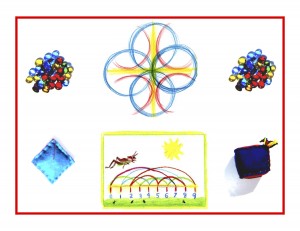
Day 22
For one year, 365 days, this blog will address the Common Core Standards from the perspective of creating an alternate, ambient learning environment for math. Ambient is defined as “existing or present on all sides, an all-encompassing atmosphere.” And ambient music is defined as: “Quiet and relaxing with melodies that repeat many times.”
Why ambient? A math teaching style that’s whole and all encompassing, with themes that repeat many times through the years, is most likely to be effective and successful. Today’s blog will focus on an overview of the Common Core Standards, their ambient counterparts, and where each activity may be placed in the structure of a typical (ambient) Kindergarten day.
The Waldorf Kindergarten day will be used as a template, dividing it into four segments: Free Play, Circle Time, Outside, and Snack/Story. Though the Waldorf model will be used for structuring the day, the suggested content is somewhat eclectic, leaning mostly toward a Montessori approach.
In the Waldorf Kindergarten, a strong advocacy for free play mixed with a generous helping of the arts, (literature, music, dance, movement, handcrafts, painting, sculpting) pairs with a steadfast avoidance of academics. This is wise, sound, and healthy for the young child till age 7. But I am holding here that in the Kindergarten it is entirely possible to build foundations with pure play, for later learning.
As I understand the Montessori approach, learning materials that are imaginative, well-made, and creatively engaging are supplied in an open space, so Kindergartners may freely “play” with them without coercion, coaxing, or testing. This is the aspect of Montessori that I feel is a good mix with a Waldorf arts-rich and warm environment.
In analyzing and categorizing the standards and their ambient counterparts, explored in this blog from Days 3-19, I found that most fit into the Free Play segment, while others blend with Circle Time and Outside, and a few with Snack/Story. Over the next few blogs, I will reference this blog’s Day number, along with the relevant standard and its activity, as well as suggestions for fitting it all together.
As stated earlier, my hope is that Ambient Math will be helpful for you who have an eye for the value of play over academics and testing, and who are homeschooling Kindergartners (with or without a Waldorf approach). And for those whose children are in public or private school, who may choose to use this content as a nurturing, supportive supplement.
To the latter, may I support you in strong advocacy for your children! So many parents are dismayed by the negative effects of early academics and testing. I see daily evidence of this in the news and on my Facebook page. Opting out of testing is gaining momentum everywhere. I read the other day about a Mom with a son in Kindergarten who is acting as a self-styled “Play Warrior” in reaction to her son’s confusion and unhappiness with stressful, repeated testing at school.
Please remember that knowledge ensues in an environment dedicated to imaginative, creative knowing, where student and teacher alike surrender to the ensuing of that knowledge as a worthy goal. More Kindergarten tomorrow!
Tags:

Day 21
For one year, 365 days, this blog will address the Common Core Standards from the perspective of creating an alternate, ambient learning environment for math. Ambient is defined as “existing or present on all sides, an all-encompassing atmosphere.” And ambient music is defined as: “Quiet and relaxing with melodies that repeat many times.”
Why ambient? A math teaching style that’s whole and all encompassing, with themes that repeat many times through the years, is most likely to be effective and successful. Today’s blog will focus on the wonderful folktale, “Stone Soup.”
Well, here I sit having wanted to wrap Kindergarten up in a sort of “index” or “contents” blog, as a summary of the ambient alternatives to the Common Core, and where to fit them in a day devoted primarily to play! I printed out all of the blogs to date and have been poring through them, trying to sum it all up in a nutshell, to make it accessible for you the reader to put to practical use.
I’m finding that it’s a bigger chunk than I imagined, and will begin it tomorrow, devoting 3-4 blogs to it. Seems there aren’t enough hours in my day of late! I’m treating you instead to a lovely version of “Stone Soup,” adapted from a Swedish folktale and from Marcia Brown’s retelling in her book “Stone Soup.” Enjoy reading it, then tell it along with the activity suggested on Day 13 of this blog.
There once was a traveler who came to a small village, tired and weary from his long journey. The traveler did not have anything to eat and hoped that a friendly villager would be able to feed him. He came to the first house and knocked on the door. He asked the woman who answered if she could spare just a small bit of food as he had traveled a long journey and was very hungry. The woman replied, “I’m sorry I have nothing to give you. I can barely feed my own family.” So the traveler went to another door and asked again. The answer was the same: “I have nothing to give you.” He went from door to door and each time was turned away. Undaunted, the traveler went to the village square, took a small tin cooking pot from his bag, filled it with water, started a fire and dropped a stone in the pot. As he boiled the water, a passing villager stopped and asked him what he was doing. The traveler replied, “I’m making stone soup. Would you like to join me?” The villager said yes, and he asked if carrots were good in stone soup. “Sure,” said the traveler. The villager went home and returned with carrots from his garden to add to the boiling water. Soon, another curious villager came by and was invited to join them. She went home and returned with some potatoes. A young boy passed by and soon joined the group, bringing his mother and dinner plates from their home. In time, a crowd gathered with everyone offering their own favorite ingredient: mushrooms, onions, salt, black pepper, acorn, squash. Everyone wanted to be part of the creation. Finally, the traveler removed the stone and declared, “The stone soup is ready!” And the whole community joined in a feast where there was none before.
Knowledge ensues in an environment dedicated to imaginative, creative knowing, where student and teacher alike surrender to the ensuing of that knowledge as a worthy goal. More Kindergarten tomorrow!
Tags:

